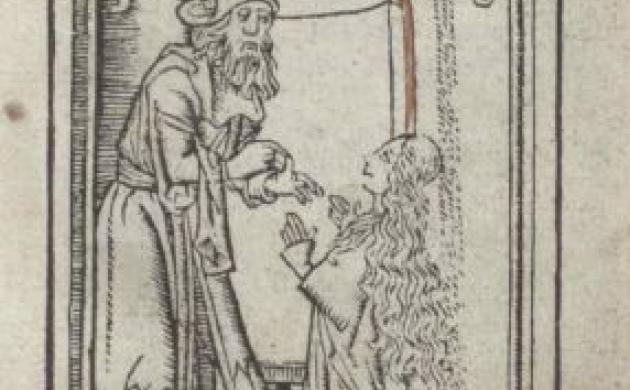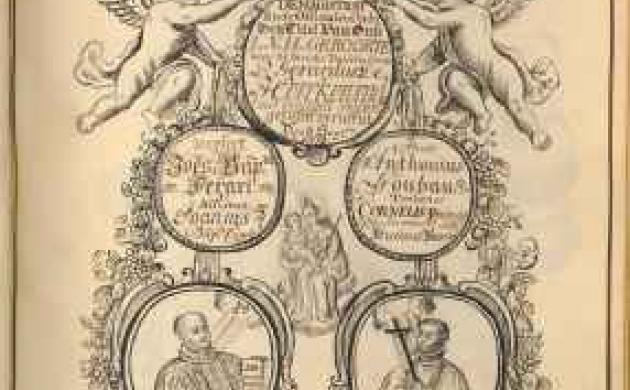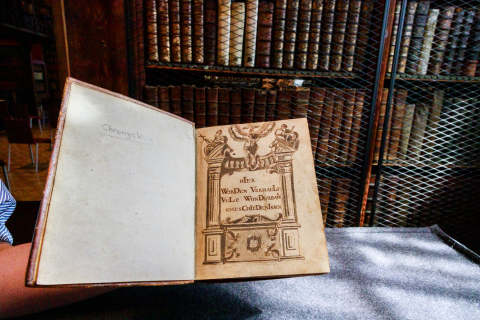
Titlepage Hier worden verhaelt vele wonderbaere gheschiedenissen, anonymous, ca. 1733. Foto: Victoriano Moreno

The coat of arms in the manuscript [on the left] and the coat of arms of the Van Havre family of Antwerp [on the right]
Why the adoration of our chronicler for the Black Madonna? This manuscript raises numerous questions and calls for more in-depth investigation. Who dares?
The 'zinnebeelden' in the manuscript are followed by over five hundred pages of 'Ongehoorde chroniicke waer in te vinden siin wondere historien' ['Unheard of chronicle in which amazing histories can be found']. Like the title page, this title includes an chronogram for the year 1733, but the handwritten chronicle continues until 1745. Among other things, the chronicle contains the following:
- 'Verscheyde antiquiteyten van de stadt Brussel anno 974' (p. 53-79);
- a broad selection of news items from the European capitals in the period 1725 to 1745, filed by year (with a cartouche for each new year) (p. 80-466);
- all kinds of chronicles, obituaries, anniversaries, memorabilia and ceremonies;
- 'Brabantsch chronycke ende vele outheden voorgevallen' (p. 467-479);
- descriptions of various cities and countries (p. 480-544).
The manuscript ends with a ‘Corte beschrijvinghe van alle gedierten, vogelen, visschen uijt Plinius’ [‘Short description of all animals, birds and fish from Plinius’]. Finally two printed texts about processions in Mechelen and emblematic exhibitions in the Jesuit Church in Antwerp (i.e. the Carolus Borromeus Church) are bound in convolute:
- Vreugde-tekenen by wyse van omme-ganck op de kermisse der stadt ende provincie van Mechelen, den 8. en 9. julii 1737;
- and Kort verhael van het konstig verciersel der kerke van het professen-huys der societeyt Jesu binnen Antwerpen, op de solemniteyt der canonizatie van de heyligen Aloysius Gonzaga ende Stanislaus Kostka (Antwerpen, Jacobus van Gaesbeeck 1727).
Who is the anonymous compiler of the chronicle? We can only guess. At first glance he does not seem to make himself known anywhere, but from his choice of marvellous news and anecdotes a clear preference emerges for religious ceremonies and events in Brabant, especially Brussels and Antwerp. With some Antwerp pride we first look for his origins in the direction of an Antwerp milieu. After all, some elements from the manuscript seem to point to (the circles around) Saint Michael's Abbey in Antwerp, such as the coat of arms on the title page and the emblems of Jacobus Moons. And then there is a lost mark of provenance that seems to point in the direction of the Van Havre family in Antwerp. On the cover page of the convolute, there are still very vague traces of ink of a removed ex-libris, which seems to show many similarities with the ex-libris of the bibliophile.
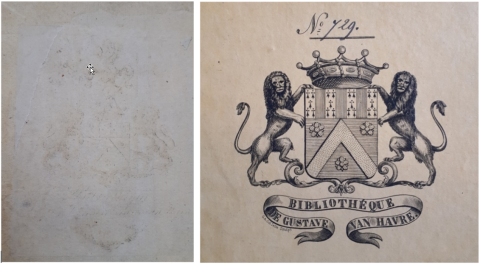
The removed ex libris in the manuscript [on the left] and one of the ex libris of Gustave Van Havre [on the right]

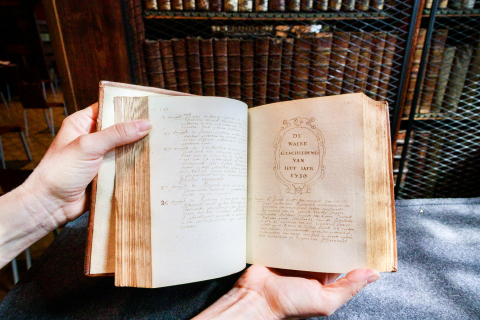
Photographs: Victoriano Moreno
Bibliography
- Luc Duerloo, ‘Het blazoen ontsmet. Adellijke heraldiek als toe-eigening van eer en deugd, 1550-1750’, BMGN - Low Countries Historical Review 123:4 (2008), pp.633–654, via DOI.
- Alfons Goovaerts, La famille Van Havre: histoire et généalogie (Antwerpen 1882).
- 700 jaar familie van Havre (Wijnegem 2004).
- Pierre Delsaerdt, Bibliofilie en publiek-private samenwerking: de veiling-Van Havre en de start van het Bestendig Dotatiefonds, 1905 (Antwerpen 2008).
- Renée Cambré, De veiling-Gustave van Havre, en het mecenaat ten gunste van de Stadsbibliotheek en het Museum Plantin-Moretus te Antwerpen, 1905 (Antwerpen 2008).
- Pierre Delsaerdt en Dries Vanysacker, Boeken erven en verwerven: de privébibliotheken van de Antwerpse kanunnik Petrus Knyff (1713-1784) en zijn vader Jacobus (1681-1756), De achttiende eeuw: documentatieblad van de Werkgroep achttiende eeuw 30 (1998) pp. 79-86.



